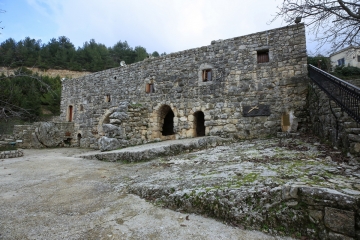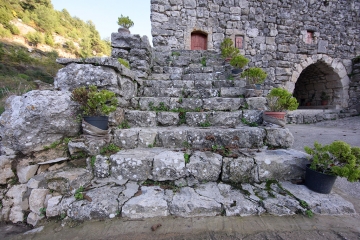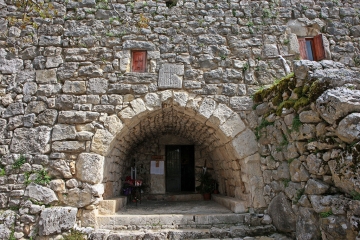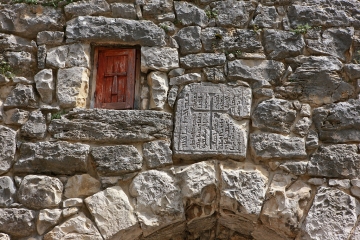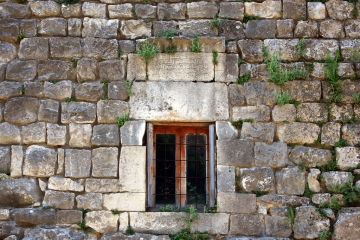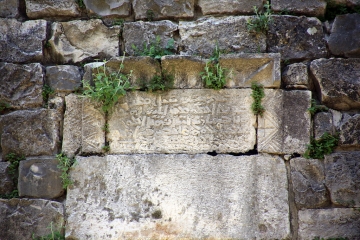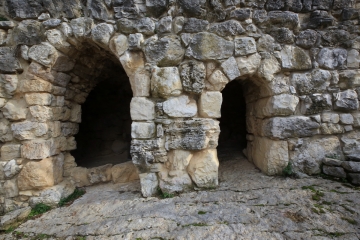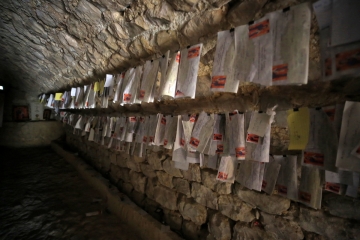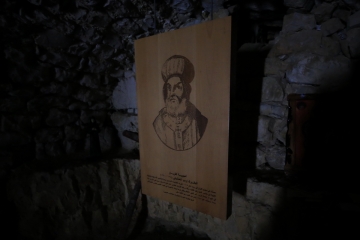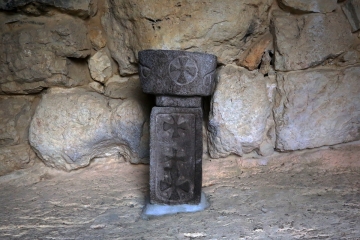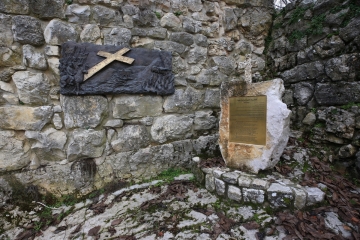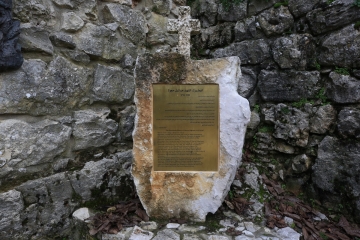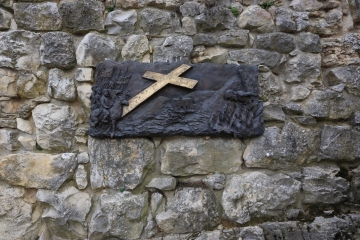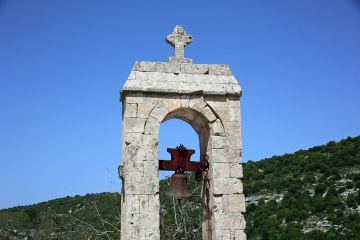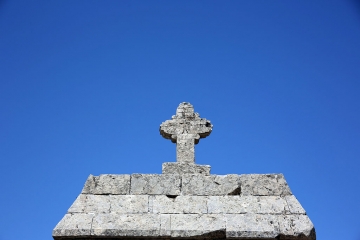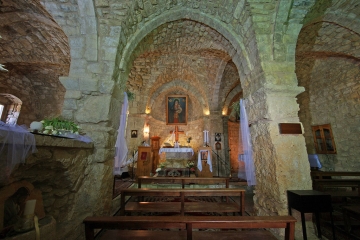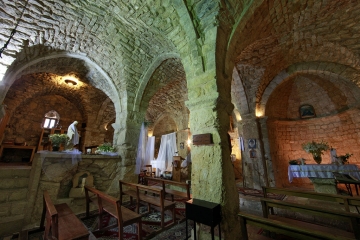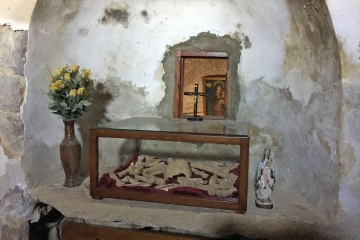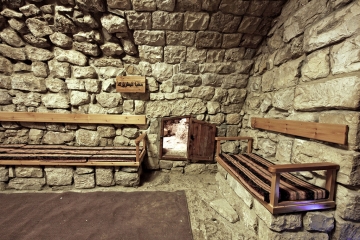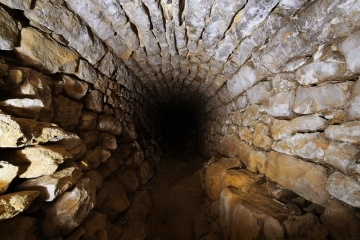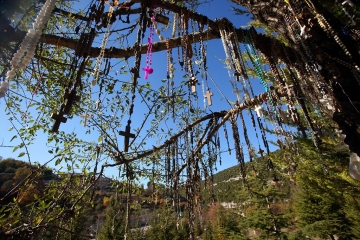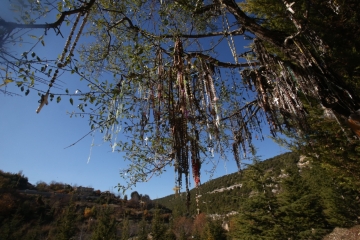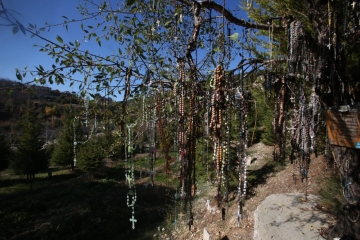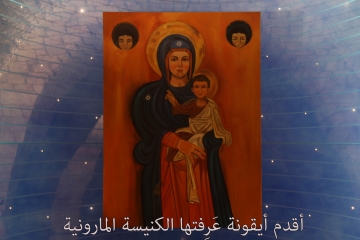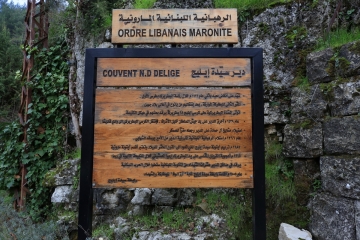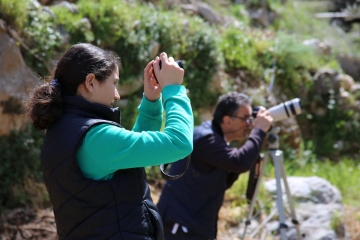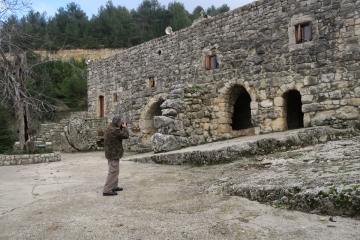دير سيّدة إيليج - ميفوق
في قلب وادٍ، وراء ستارٍ كثيفٍ من الحَور والصِفصاف والجَوز، تَبرُز للنظر قبّة جرسٍ صغيرة بيضاء تقوم على بعض الرَدميّات التي تُغطيها الأعشاب. وإذا أجال المرء نَظره في ما حواليه يَجِد نَفسَه في قَعرِ وادٍ تُحيط به تلال رَمادية اللون. إنه عشٌّ سِحريّ لا تَستطيع فيه الأعين والنفوس إلا ان ترنو الى فوق، الى السماء. في وسط هذا الاطار الطبيعيّ، وبين الخرائب والانقاض، قلب لا يزال ينبض بالحياة.. هو هيكل سيّدة إيليج.
هذا وَصف لذلك المكان المُقدَّس، وللِمَعبَد الذي أكسبه القداسة، مُستوحىً من كلمة للأب غودار اليَسوعي وَرَدَت في كتابه "السيّدة العذراء في لبنان" الذي كتبه إثر زيارته لبنان عام 1908 بمناسبة رفع تمثال العذراء مريم على قِمة جبل حريصا. ويَستطرِد الأب غودار قائلاً: "هنا أقام مدّةً طويلةً من الزمن بطاركة الموارنة. هنا، على أقدام السيّدة العذراء، تعذَّبوا واضطُّهِدوا وَشَقوا. وفي جوار هذا الهيكل الوادع ارتفع، في التاريخ، ضجيج السلاح، وملأ سماء الوادي دُخان الحرائق، واختلطت مياه النهر بالدماء البريئة، ومن هنا، أكثر من أيّ مكانٍ آخر في لبنان، مَرَّت أشباح الدماء والدمار".
وتاريخ هذا المعبد نَستقيه من نشرةٍ بعنوان "سيّدة إيليج" تقول أنه ربما كان هناك مَعَبد وثنيّ لإله اللُّجَج والأعماق. وهناك تَقليد يقول: "إن مبنى دير سيّدة إيليج يقع عند إحدى مَحَطات الطريق الروماني المؤدّي من بعلبك وضِفاف نهر العاصي الى ساحل فينيقيا الشماليّ، وإن الرُسل القدّيسين ساروا على هذا الطريق خلال تَنَقُلاتهم بين إنطاكية وشواطئ فلسطين، وإليهم يُنسب تحويل إيليج الى بناءٍ مسيحيّ". والمَسعودي المؤرِّخ يقول: "حين دُمِّرَ دير مار مارون العاصي فَرَّ البطاركة الى جبال لبنان العَصيّة ووديانه الصَعبة المسالك.. عبر طريقٍ رومانيّ يمتدّ من اليمونة الى يانوح، ومنها الى وادي إيليج".
عاش البطاركة في إيليج عيشة المُتوحدين التي تَتَّصِف بالبساطة، يُمارسون الفُقر كرعاياهم الموارنة، ويشاركونهم شَظف العيش، ويتلون الصلوات معاً، راضين بِمُجرّد اللِقمة ورائدهم الوحيد إيمانهم وقداستهم. ونقرأ في عدد من مجلة "الميناء" التي كانت تصدرها الرهبانية المارونية اللبنانية، فَنَطَّلِع على أن السائح شمبون (1869) كتب ان هذا المعبد كان هيكلاً للزُهرة وتحوّل الى كنيسة على اسم العذراء مريم. ويخبر جبرائيل القلاعي أسقف نيكوسيا (قبرص) اللبنانيّ الأصلُ والنشأة ان هذه الكنيسة بناها بطرس وفيليبّوس الرسولان.
وتاريخها يُظهِر منذ القرن الثاني عَشَر عِبر أوراقٍ مَحفوطةٍ في الدير.. وكِتابتين أثريتين منقوشتين في الجِدران، وكُلها يُحدِّد تاريخ بناء هذا الهيكل. إحدى الكتابتين موجودة فوق عتبة شبّاك الكنيسة الشمالي، وهي باللغة السريانية، والثانية، وهي سريانية أيضاً ولكن بالحرف الأسطرنجلي، فوق عتبة باب الهيكل، وترجمتهما كما جاء في كتاب الأب بطرس ضو "تاريخ الموارنة":
الكتابة الأولى: "باسم الإبن الحَيّ الدائم، في سنة 1746 مَسيحية تَجَدَّدَ هذا الهيكل على يد الأخوين الكاهنين أمّون ومينع، وهو من صِنع أربعة بطاركة: بطرس وإرميا ويعقوب ويوحنا عام 1121".
أما الكتابة الثانية فهي: "باسم الله الحي للدهر، في سنة 1588 لليونان (1277 م) كمل بُنيان دير والدة الله مريم، لِتكُن صلاتها معنا، على أيدي الرجال الخطأة: القَس داود وبطرس ويوحنا". كما نُقش صليب على هذه المنحوتة وعلى جوانبه الآية السريانية: "بك نَقهُر أعداءنا، وباسمك نَطأ مُبغِضينا".
وللإيضاح نذكر أن الفرق الزمني بين التقويمين المذكورين اعلاه هو 311 سنة.
ويُذكر ان الكتابة الثانية جرى وضعها أثناء التشييد.. وذلك بغير ما يجب ان يكون عليه إتجاهها، مِمّا يُعتقد معه على الأرجح أن الباني كان يجهل القراءة.
يُستنتج من ذلك أن هذه الكنيسة تَمّ بِناؤها على عِدة مراحل :
أنشأها البطاركة بطرس وإرميا ويعقوب ويوحنا اعتباراً من السنة 1121 م.
أكملها القَس داود ومُرقس ويوحنا في السنة 1277 م.
جَدَّدَها الأخوان الكاهنان أمون ومينع في السنة 1746م.
جَدَّدت الرهبانية بناء الدير سنة 1786م كما ذُكر على موقع الرهبنة اللبنانية.
جُدِّد مرة أخرى بين عامَي 1945 و1950 إبان رئاسة الأب نعمة الله خوري الكفروني كما ذُكر ايضاً على موقع الرهبنة اللبنانية.
ويُستخلص من كلام هؤلاء المؤرخين أن البطاركة الموارنة أرادوا الإقتراب من الصليبيين المُحْتلّين الشواطئ، فَهَجِروا هِضاب سيّدة يانوح نحو السنة 1120م وهبطوا وادي إيليج، وهناك أقاموا أو رمّموا هذا الهيكل على أنقاض هيكلٍ بيزنطيّ وجَعَلوه على اسم مريم العذراء، فحمل هذا الكرسيّ البطريركيّ الجديد اسم "دير القديسة مريم في ميفوق".. التي تعني النبع او الماء الفوقاني.
أما تسمية "إيليج" فيُحتمل أن تكون ذات اصلٍ إغريقيّ، ولكنه احتمال بعيد، أو ذات أصلٍ ساميّ ينسبها إلى الإله "أيل"، لا إلى "إيليجبيل" إله اللُّجَج والأعماق، وقد يكون الشعب الآرامي جَلَبَ الاسم السّامي معه ممّا بين النهرين.
وفي مقالٍ للأب ميشال الحايك ان اسم "إيليج" ورد قديماً في عِداد الأمكنة الأسقفية ببلاد ما بين النهرين، وذلك حَسب الكتابات السِريانية، ويرى ان الأصح في تفسير أصله انه مأخوذ عن لفظة "هليوس" اليونانية ومعناها "الشمس"، فيكون المَعبَد المَقصود قد بُني على أنقاض هيكل لإلهة الشمس. ثم ان هناك لفظة ألمانية مأخوذة دون شكٍ عن اليونانية تقرب من كلمة "إيليج" ومعناها "القداسة" كمعنى "قاديشا" بالسريانية، وسيّدة إيليج، أي "السيّدة القدّيسة"، هي، في التاريخ المارونيّ، قبل "قاديشا" أو هي قاديشا الأولى.
ويقول الأب خليفة حول هذا الدير: "من هذا المعبد كان البطريرك يُرفِق اسمه بصِفة "الحقير". وفي هذا الهَيكل كان مقرُّ البطريرك يُرقى إليه بِدَرَج وضيع يوصِل إلى غرفةٍ كانت كل قَصرِه من هذه الدنيا، وثروته فيها كُتُب عَتيقة عليها اصفرار الشَمع والدَمع، ووليمته فُطور على جَسَد الرب، ولَيلِه سَهَر للتَضَرُّع، ونهاره همٌّ على الشعب وتعبٌ في الأرض. فكانوا حَقيرين بالمُمتلكات، كبيرين بالذات، يَصومون نِصفَ السَنة وأكثر، ويَلبسون المُسوح، ويُعَمِّمون رؤوسهم بإسكيمهم الرهبانيّ ويُغطّون أجسادهم النحيلة بِرُقعةٍ زرقاء، لا يأكلون مَدى حَياتهم كُلِّها لَحماً، ولا يشربون خمراً الا من كأس الخَلاص، ولا يَحملون عصاً إلا من خشب يتوكأون عليها لقومات الصلاة الأربع في كل هزيع من الليل؛ يُساهرون الملائكة، وإذا ناموا فوجوههم إلى القُربان".
لماذا كان البطاركة الموارنة قُدماء العهد في منطقة جبيل؟ يقول الأب الحايك إن الشاهِد على ذلك هو أن مُعظَم البطاركة هم من تلك القُرى التي نَمرُّ بها في طريقنا إلى إيليج: الصفرا، حالات، جبيل، عمشيت، دمَلصا، الكَفر، شامات، حاقِل، مَيفوق، حجولا، هابيل، لحفد، جاج، العاقورة، كفيفان، رامات، حردين وحدشيت... ففي هذه القرى كان للبطاركة، في العهد الإيليجي، مقامات مؤقتة زمنَ الاضطهاد والتخفِّي، ومن وادٍ إلى جَبل تَتَعاقَب تلك الضياع حاملةً في اتضاعها وحِشمَتها ذِكريات أولئك البطاركة القديسين الذين كانوا يُسَيّرون شَعبهم ويوجّهونه وليس لهم من وسائل العالم لا مال ولا سلاح ولا جيش ولا عتاد ولا مذياع ولا صحافة، بل شَعشَعَة الوجه، وألق الروح، والحياة المبذولة في عمل افتداء قُربانيّ مَحض. وإذا كانت لهم رابطة بالحَرَكَة الصَليبية في تلك العُصور، فَمِن حيث إنهم كانوا حمَلة صليب لَصِق بوجودهم منذ البدء، قبل عهد الصليبيين وبعده، فكان كل نصيبهم من الوجود.
بالنسبة إلى الدير فقد شُيّد في عهد البطريرك المارونيّ بطرس الأول، وهو مؤلف من طبقتين، وكنيسته تَستوقِف النظر ببنائها المُرَبّع ذي الهَندَسة الفريدة، إذ أنه بُني وفقاً لأصول الفنّ الذي كان شائعاً قبل ظهور الأشكال الغوطية الكبرى، بِحَيث تَتَمَيز بِخصائِص الهندسة المارونية الأصلية ومنها وجود "البيما"، أي المَصطَبة التي تكون عادةً مُرتفعةً قليلاً عن أرض الكنيسة، وعليها كان يجلس البطريرك والأساقفة في أثناء القداس. وحجارة البناء من الدَبش، ومداخله واطئة، وهو كان مركزاً لإقامة البطاركة الموارنة من سنة 1121 إلى 1440. وأثناء إقامتهم فيه سَكَن البعضُ مِنهم، لفترات مَحدودة، في أمكنة أخرى: إما في قُراهم او مناطقهم او أديرةٍ أُخرى.. لأسباب نجهلها.
وفي هذا الدير كنزٌ ثمين، إذ إنه يحتوي على أقدم أيقونة عَرَِفتها الكنيسة المارونية، وهي التي يقول عنها الأب بطرس ضو في كتابه "تاريخ الموارنة" إنها السيّدة أم النور عند الموارنة كما جاء في كتاب "الهُدى" الماروني مُعاصر صورة سيّدة إيليج (طبعة فهد ص 256)". ويُفيدنا الأب عبدو بدوي، من الرهبنة اللبنانية المارونية، ان هذه الأيقونة وُجِدت في المقرّ البطريركي الماروني في منطقة القِطّارة – ميفوق، في دير سيّدة إيليج هذا، وقد رافقت البطاركة من سنة 1121 حتى سنة 1440 أي حتى رحيلهم إلى وادي قنّوبين، وبعد رَحيلهم بَقيت مَحفوظة حَيث هي في صِندوقٍ.. مُتعرضةً لكثير من العوامل السَلبية بِسَبَب عَدَم المُحافظة عليها بِشكل جيّد، إذ أصابها الحريق، وشُوّهت في أسفلها، بالإضافة إلى أسبابٍ أخرى أضَرّت بها. فَجَرى تَرميمها لدى راهبات كَرمِل الوحدة في حريصا المُتَخَصِصات في هذا المجال، واستغرق الترميم حوالي ستّ سنوات بدءاً من العام 1985. إلاَّ أنه عندما بوشر بالدراسات المَخبَرية والتصوير بالأشعة كانت المفاجأة.. وهي أن الصورة تَحتَوي على عِدَّة طَبَقات تَصويرية مُتراكمة يَرجع أقدمها إلى القرن العاشر، أي أنها ثروة تاريخية وفكرية وفَنيَّة وإرث كبير. وقبل تَرميمها لم يكن عُمرها معلوماً، فكانوا يَعتبرون أنها رُسمت قبل 200 عام كحدٍّ أقصى، ولكن اكتُشف بِفَضلِ ما أُخضِعَت له من دراسة ومعالجة أنها أقدم أيقونة مارونية في لبنان وبلدان الانتشار.
وقد ألقُيَ الضوء على ثلاثة أمور أساسية في الأيقونة، أولها ان الشَمس والقَمر اللذين يظهران في أعلاها يَشيران إلى أن العذراء مريم هي سُلطانة الليل والنهار، ولكنَّ هذا الرمز تَحَوَّل على مَرّ الزمن، بعد سلسلة التَرميمات التي خضعت لها الأيقونة، إلى رأسَي ملاكين في أعلاها في الطبقة العاشرة منها، وقد يكون ذلك نتيجة التأثير الغربي. وثاني الأمور هو وجود ثلاث نُجوم، واحدة على جَبين العذراء، وأخرى على كَتفها اليُمنى، وهي في يدها اليُسرى تَحمِل يسوع وهو النَجمة الثالثة، مما يرمز إلى الحَبَل بلا دَنَس.
والأمر الثالث، أخيراً، هو أن اللَونين الطاغيين على الأيقونة هما اللون الأزرق واللون التُرابي، وفي علم الأيقونات يرمز اللون الأزرق إلى الدَيمومة واللون التُرابي إلى كل ما هو زائل. والعذراء في هذه الأيقونة تَجمَع اللونين، أي أن الله وَشَّحَها باللون الأزرق لكي تَكون أمّاً لله الإبن. وبالإضافة إلى ذلك يُلاحَظ وجود هالةٍ حول رأس العذراء هي عبارة عن اثنتي عشرة قِطعَة نَقدية مُستوحاة من سِفر الرؤيا الذي يتكلم عن المرأة الجَديدة التي تَحمِل على رأسها إكليلاً من اثني عشر كوكباً وتحت قدميها القمر، وهي حوّاء الجديدة التي وهبت الحياة. وتجدر الإشارة إلى أن التصميم الأساسي يُظهر لنا صورة "العذراء المُوَجِّهة"، وهي من النوع السريانيّ العريق الذي يعود إلى الأجيال المسيحية الأولى. ومن الخصوصيات السريانية أيضاً في الصورة فَتحَة المنديل حول رأس العذراء ( إم النور).
ولكن لماذا ترك البطاركة إيليج نهائياً بعد اقامتهم فيها؟
إن الموارنة، بعد رحيل الصَليبيين عن بِلادنا، تِعَرَّضوا لكافة أنواع الاضطِهاد. ففي سنة 1367، في عهد البطريرك جبرائيل حجولا (1357-1367)، اجتاحت عَساكر المَماليك أرض لبنان، وهاجَمَت القُرى المَسيحية وأوسَعَتْ فيها تقتيلاً وتخريباً، كما أقدموا على قتل البطريرك.
فَخَلَفَهُ داود يوحنا (1367-1404) الذي انسحَب إلى هِضاب حَردين.. وسوف نتكلم عنه في سياق التكلم عن دير مار سركيس القرن – حردين، ومن ثم البطريرك يوحنا الجاجي (1404-1445) الذي عاد إلى سيّدة إيليج سنة 1404 (اي سنة إنتخابه)، وقد تَعرَّضَ هو أيضاً إلى مَخاطِر المماليك.. مما حدا به إلى نقل البطركية إلى وادي قنّوبين مُدشِّناً عهد انتقال البطاركة إلى هذا الكرسيّ الجديد بحيث كان آخر بطاركة إيليج.
وبعد ان هَجَر البطاركة سيّدة إيليج جَعَلها آل حمادة مركزاً لِحُكمِهم، وتعاقبوا عليها حتى سنة 1686 حين دارت حروب قرب الدير. ولكنّ إيليج تَجَدَّدَ مجدها وإزدهرت وهي تحت ولاية الحمادية المَتاولة. ويُقال أنهم احترموا بيت مريم، حتى أن أحدهم أُغْرم بهذه السيّدة التي قال إنها نَجَّتهُ من الموت في إحدى المعارك. وبعد ذلك، في معركةٍ أخرى أشرف فيها الدروز على مُحاصرة المتاولة، هَرَعَ هؤلاء إلى حماية سيّدة إيليج وقدّموا لها قطعة ارضٍ هديّة، والشائع ان ضَباباً كثيفاً هَبَط حالاً وسَتَرَ هَربهم عن أعين أعدائهم.
البطاركة الذين سكنوا إيليج: عددهم وأسماؤهم
هذا العدد، حسب الاعتقاد الشائع عموماً، هو إنهم ثمانية عشر بطريركاً، رُغم بَعضَ اللوائح التي وَرد فيها أنهم ثلاثة عشر. ولكنَّ نيافة الكردينال مار بشارة بطرس الراعي حَسَم النِقاش حَولَ هذا الموضوع بإشارته إلى البطاركة الثمانية عشرعندما قام بزيارة هذا الدير الأثري وَفاه فيه بهذه الكلمات التي تُلَخِص جانباً من تاريخ هذا الدير: "ليتَ الحِجارةُ تَتَكَلَم كي تُخبرنا عن 300 سنة من حياة البطاركة التي أمضوها هنا منذ عام 1121 حتى عام 1440، بعيدين ومُتجنبين ظِلِّ الظالمين في كُل عَهد المَماليك. واليوم نَسْتَحْضِر أرواح كل البطاركة القديسين الـ 18 الذين دُفنوا هنا في سيّدة إيليج، وكل البطاركة الذين تنقَّلوا في بلاد جبيل من إيليج إلى يانوح، ومنها إلى أكثر من ستة مراكز كانوا فيها حاملين عروشهم على ظهورهم وقضيتهم في قلوبهم، وفي فكرهم الإيمان المسيحي".
إن البادئ بانشاء دير سيّدة إيليج كان البطريرك بطرس الأول (1121-1130) من سمار جبيل، كما جاء في الكتابة المحفورة فوق عَتَبة الشبّاك الشمالي حَسبَ ما ورد أعلاه. وقد ورد أيضاً ذِكر هذا البطريرك بطرس في حاشية على الصفحة 262 من الكتاب السرياني السابع الذي نقله السِمعاني إلى المكتبة الفاتيكانية وهذا تعريب الحاشية المذكورة : " أنا الحقير الراهب سمعان كَتَبتُ هذه الأسطر في هذا الكتاب الذي نسخته لأبينا الطوباوي بطريركنا مار بطرس الساكن في دير ميفوق المُقدَّس في وادي إيليج من عمل البترون إلى أن أمرني بأن أكون رئيساً وناظراً في أرض كوزبند بجزيرة قبرس ...". والكتاب الذي دُوِّنت عليه هذه الحاشية يَتَضَمَّن نسخة عن ميامر مار يعقوب السروجي مُزينة بالصُوَر، وكان لا يزال في قنّوبين في أيام الدويهي، وقد نَقله السمعاني إلى الفاتيكان حيث لا يزال مُصاناً هناك. وفي هذا العَهد كان بودوان الثاني ملكاً على أورشليم. وفي خلال هذه الفترة، أي في العام 1124 تحديداً، سقطت صور في أيدي جند أورشليم الصليبيين، وعام 1129 هاجم الصليبيون دمشق للمرة الأولى.
أمَا البطريرك الذي عقب بطرس الأول هذا فهو غريغوريوس الحالاتي (1130-1141) من بلدة حالات في بلاد جبيل، وقد سكن في إيليج، وأوفد إليه البابا إينوشانسيوس الثاني(1130-1143) الكاردينال غوليلموس في سنة 1130، وفي عهده حصل مَقتل بوهيمون الثاني ملك أنطاكية الذي قام على عرشها من 1126 إلى 1130. وإذ كان الصليبيون في عهده، أي في العام 1136، على خلافات داخلية في ما بينهم، فقد حاول هذا البطريرك إقامة حوار مع العرب ولم يعترض على نفاذهم إلى الساحل.
وبعده جاء البطريرك يعقوب الراماتي (1141-1151)، من بلدة رامات في بلاد البترون، الذي في أيامه تُرجم الإنجيل إلى اللغة العربية على يد القَس عبدالله ابو الفرج المعروف بإبن الطبيب. وقبل نهاية ولايته، أي في 1150، نُقل قِسماً من ذخائر القديس مارون إلى إيطاليا لحمايتها هناك...
وجاء على أثره البطريرك يوحنا السابع المعروف بيوحنا اللحفدي (1151-1154)، وسوف نتكلم عنه في سياق التكلم عن دير مار الياس لحفد حيث سكن. وخلفه البطريرك بطرس الثاني (1154-1173) الذي ذكره السمعاني، وكان الخامس من البطاركة الذين سكنوا إيليج.
وجاء من بعده البطريرك بطرس الثالث (1173-1189).. تبعاً لما ذكرته "الموسوعة الحرة" التي تذكر أسماء البطاركة الموارنة الذين تعاقبوا خلال الحقبة الصليبية (1099-1305)، وهو قد ذكره السمعاني أيضاً في عداد بطاركة إيليج. وكان خَلَفَهُ البطريرك بطرس الرابع (1189- 1199) الذي نعرفه عن طريق السمعاني كذلك، فتولّى من حين وفاة سلفه إلى العام 1199، وسكن أيضاً إيليج.
ولكن، هنا مع بطرس الرابع، يُطالعنا اسم بطرس اللحفدي الذي يُعتقد أنه بطرس الرابع نفسه، وهو الذي زار، سنة 1182، بطريرك أنطاكية اللاتيني إيمريك وأفهمه أن الموارنة هم طائفة كاثوليكية قديمة مؤلفة من الذين لم يتبعوا بِدعةً قط، وقد أنجدوا الصليبيين على الأعداء في زحفتهم الأولى (1096-1099) وزحفتهم الثانية (1147-1149)، ورغب إليه ان يُقدّم خضوعهم وطاعتهم واحترامهم للكرسيّ الرسولي. فإطَّلع على ذلك ولهلم أسقف صور على اللاتين، فأثبت هذا الحادث في تاريخه بِصِفة رجوع إلى حُضن الكنيسة الرومانية على عادة الإفرنج في كتاباتهم عن عوائد بلادنا. (عن مجموعة البيَّنات المارونية، العدد 23). وشهد عَهد هذا البطريرك حصول الحملة الصليبية الثالثة في العام 1189. وعام 1191 إستولى ريكاردوس على قبرص، كما استعاد، في العام نفسه، الصليبيون عكَا، فكان بطرس اللحفدي أيضاً من عداد البطاركة الذين تعاقبوا خلال الحقبة الصليبية، وبعد وفاته بسنة، اي في العام 1192، عُقِدَ الصلح ما بين صلاح الدين الأيوبي وريكاردوس.
والبطريرك الذي خلفه كان إرميا العمشيتي (1199-1230) الذي طالت بطريركيته مدة 31 سنة، وقد ذكرناه في مَعرَض ذِكرنا البطاركة الذين سكنوا يانوح.
وتذكر نشرة "سيّدة إيليج" أن مَن جاء بعد البطريرك إرميا العمشيتي كان البطريرك دانيال الشاماتي (1230-1239) الذي انتُخب في دير سيّدة إيليج في ميفوق، ولكنه أضطرَّ إلى مغادرته بسبب الحروب والفتن المَملوكية، فإنتقل أولاً إلى دير مار قبريانوس ويوستينا (كفيفان)، ثم إلى دير مار يوحنا مارون (كفرحي). وحَسَب الدويهي أنه في سنة 1236 كان مُقيماً في دير مار جِرجِس الكَفر (جبيل)، جاعلاً انتقاله إلى دير القديس مارون كفرحي بعد نقل الكرسيّ البطريركي إلى دير مار جرجس الكفر، بينما تقول نشرة "سيّدة إيليج" انه من سنة 1236 إلى 1239 (سنة وفاته) كان قاطناً في دير مار جِرجِس الكفر حيث مات ودُفن.
أمّا البطريرك يوحنا بطرس الجاجي (1239-1245)، الذي جاء على أثر الشاماتي، فقد أنتُخب في دير سيّدة إيليج وأقام فيه لفترة، ومن ثم انتقل إلى دير سيّدة يانوح، وعاد من بعد إلى إيليج.. ليعود فيقيم ويموت ويُدفَن في يانوح، أمّا نشرة "سيّدة إيليج" فتقول انه إنتُخب ومات في إيليج.
وتتابع هذه النشرة قائلةً:" وكان خليفته البطريرك سمعان بطرس (أو شمعون الرابع) (1245-1277) حسب رواية البطريرك مسعد (1845-1890)، الذي لم يُنتخَب في إيليج ولم يَسكُن فيها، بل أنتُخب في دير سيّدة يانوح، وسَكَنَه وتوفّي فيه. وكان بعد سنة على إنتخابه قد أرسل البابا اينوشنسيوس الرابع (1243-1254) الأب لورنسيوس الفرنسيسكاني زائراً رسولياً إلى الطائفة والشعب الماروني. وفي عهده قرَّر ملك فرنسا لويس التاسع، عام 1270، قيادة حملة صليبية جديدة إلى الشرق، فإستعدَّ عشرون ألف مُقاتل ماروني لمُلاقاتِها بِصِفة نَجدَة لمعاونة الملك لويس في حربه ضد حاكم عكّا، وكان قائدهم الأمير سمعان، ولكن بِسبب تفشّي وباءٍ قتّال بين جنود الحملة لم تُكْمِل طريقها إلى القدس. وكان الملك قد كتب رسالةً إلى الأمير سمعان وُجدت مَحفوظةً في خزانة الكرسيّ البطريركي في دير قنّوبين مُترجمةً عن الأصل اللاتيني إلى الفرنسية والعربية، أما الأصل فكان قد فُقد مع ما فُقد من اوراق الكرسيّ البطريركي.
وكان خليفة سمعان بطرس البطريرك يعقوب الثاني (1277- لم يُحدد تاريخ وفاته).. الذي سكن دير سيّدة إيليج وجدَّده.
وبعده جاء البطريرك دانيال الحدشيتي (1278-1282) الذي دامت بطريركيته حوالي خمس سنوات، بينما يشير البطريرك بولس مسعد إلى إنها امتدت لمدة ثماني سنوات. وهذا البطريرك هو من حدشيت في جِبَّة بشرّي، وقد سَكن في إيليج، وفي عهده وصلت حملة المماليك، بقيادة الملك الظاهر والي طرابلس، فَتَصَدّى لها الموارنة الهابطون من جِبالهم وأوقفوا تقدُّم المماليك إلى جبل لبنان. فأعاد هؤلاء الكرَّة، فلم يتمكنوا أيضاً من التقدم. فوجَّهوا، في اوائل سنة 1282، حملة كبيرة على جبل لبنان بقيادة السلطان قلاوون، ولاقاه حسام الدين من دمشق وحاصروا جبَّة بشرّي، وإجتاحوا حصرون والحدث، وكذلك حاصروا الموارنة المُتحصنين في إهدن بقيادة البطريرك دانيال، الذي كان يقود المقاتلين الموارنة بنفسه مدةَ اربعين يوماً، ولكنهم لم يتمكنوا من اقتحام إهدن إلاّ بالحيلة، فقبضوا على البطريرك وقتلوه ودُفن في إيليج، وكان ذلك سنة 1282. وقد كتب الدويهي عن ذلك قائلاً: "سنة 1283 قاد البطريرك الحدشيتي رجاله وقاوم جيوش المماليك عندما زحفت على جبَّة بشرّي، واستطاع ان يوقف هذه الجيوش أمام إهدن أربعين يوماً، ولم يتمكنوا منها إلاّ بعد ان أمسكوا البطريرك بالحيلة".
ويقول ابن الحريري في "تاريخ 1300": "لم يتمكن المماليك من أن ينتزعوا طرابلس من أيدي الصليبيين إلاّ بعد ان أجهزوا على مُقاومة حُلفائهم الموارنة. ففي سنة 1283 صَدَّ رجال البَطريَرك دانيال الحَدشيتي جيوش المَماليك عندما زحفت على جِبَّة بشرّي واستطاعوا ان يوقفوا الجيوش أمام إهدن أربعين يوماً، ولم تَتَمَكَّن الجيوش من إحتلال المنطقة إلا بعدما أمسكوا البطريرك بالحيلة، وكان القَبض على البطريرك أعظم من إفتتاح حُصن او قلعة".
والقاضي محيي الدين أبو الفضل بن عبد الظاهر يُسمّي هذا البطريرك "بطريرك الحدث"، وقد رَوى خبر إمساكه والقضاء عليه كما يلي: "إتفق أن في بلاط طرابلس بطركاً عتا وتَجبَّر، واستطال وتَكبَّر، وأخاف صاحب طرابلس وجميع الفرنجية، وإستغوى أهل تلك الجبال وأهل تلك الأهوية من ذوي الضلال. واستمرَّ أمره حتى خافه كل مجاور. وتحصَّن في الحدث، وشمخ بأنفه، وما قدر أحد على التحيُّل عليه.. من بين يديه ولا من خلفه، ولولا خوفه من سَطوَة مولانا السلطان لخرَّب تلك البلاد، وفعل ذلك او كاد. فاتفق ان النواب ترصَّدوه مراراً فما وجدوه. فقصده التركمان في مكانه وتحيَّلوا عليه حتى أمسكوه وأحضروه أسيراً حسيراً، وكان من دعاة الكفر وطواغيهم، واستراح المُسلمون منه وأمنوا شرَّه، وكان امساكِه فتوحاً أعظم من إفتتاح حصن او قلعة، وكفى الله مكره".
دُفن هذا البطريرك في دير سيّدة إيليج سنة 1282، وكانت سالومي إبنة الخوري باسيل البشرّاوي قد بَنَت كنيسة مار دانيال في حَدَث الجِبّة في العام 1110.
يُلاحَظ أن الدويهي وابن الحريري يجعلان سنة زحف المماليك على جبَّة بشرّي وإمساكهم البطريرك دانيال هي السنة 1283 لا 1282. وقد ورد في مخطوط عن البطريرك دانيال: "دانيال من قرية حدشيت، وصورته مرقومة في كنيسة قريته. وفي سنة 1283 ثارت نيران الحروب في بلدة فونيقي ما بين النصارى والمسلمين، وهجم سيف الدين قلاوون على جِبَّة بشرّي فملكها، ثم أعقبه لوقا من بنهران". وقد ورد إلتباس في هذا المخطوط ما بين دانيال من شامات ودانيال من حدشيت.
وتعريفاً بهذا البطريرك الشهيد نورد أنه الثاني من البطاركة باسم "دانيال"، والبطريرك الخامس والثلاثون من البطاركة الموارنة. وقد ثبَّته البابا نقولا الثالث (1277-1280) سنة 1280، وأمره بأن يتخذ الميرون من زيت الزيتون ومن دهن البَلسَم لا غير، وكان المَيرون من قَبل يُتَّخذ من إثنتي عشرة مادة من انواع الزيوت والطيوب.
ولكنَّ التواريخ تذكر أن مَقتَل البطريرك الحدشيتي أدّى إلى إنتهاء الانقسام الذي حصل بين الموارنة في ذلك الزمن بحيث كان هناك بطريركان معاً: البطريرك الحدشيتي، ومُقابله بطريرك آخر باسم لوقا من بنهران (1282- لم تحدد سنة وفاته)، وسنتكلم عن ذلك مفصَّلاً في سياق عرضنا لدير سيّدة ديرونا برحليون. ويتبيَّن من ذلك ان مقتل البطريرك الحدشيتي أعاد إلى الموارنة وحدتهم الكنسية بانتخاب البطريرك إرميا الدملصاوي (1282-1297) الذي سنتكلم عنه في سياق كلامنا عن دير مار جرجس- حالات المقدّس.
وهنا، في سلسلة البطريرك مسعد (1854-1890)، أن مَن عقب البطريرك الحدشيتي كان لوقا (1282- لم تحدد سنة وفاته) من قرية بنهران ، وهو لم يُنتخب في إيليج ولم يَسكن فيها. ثم كان البطريرك إرميا الدملصاوي (1282-1297) الذي أنتُخب في دير حالات المقدّس وسَكَن في دير سيّدة إيليج وبقي فيه حتى مات سنة 1297.
ثم خلفه سمعان (1297-1339)، وسمعان هذا، المدعو شمعون الخامس (1297-1339)، سكن في إيليج خلفاً للبطريرك إرميا الدملصاوي المتوفى سنة 1297، وفي عَهده بدأت أفظع حملة تنكيل جرَّدها المماليك على الموارنة، وبِشكل لم يَعرَفه التاريخ الماروني من قبل. وفي سنة 1302 وجَّه المماليك حَملة على جبل لبنان، فواجههم الموارنة بقيادة مقدّميهم: خالد مُقدّم مِشمش، سنان، وأخوه سليمان، مُقدّما إيليج، سعاده وسركيس مُقدّما لِحفد، عَنتر مُقدّم العاقورة، بنيامين مُقدّم حَردين، وعند مدخل جبيل كانت الموقعة الرهيبة التي قُتل فيها حمدان قائد جيوش المماليك. يُذكَر أن وهذا الحَبر، قبل أن يُصبِحَ بطريركاً، كان أسقفاً على جزيرة قبرص.
وقد خلفه البطريرك يوحنا العاقوري (1339-1357)، الذي لا معلومات عن كيفية إدارته الكرسيّ البطريركيّ ولا عن الأحداث التي جرت خلال مدّة حبريّته او الإنجازات التي حققها.. وذلك في غياب المستندات العائدة لذلك. ويُذكر ان البطريرك بولس مسعد (1854-1890) أورد أن البطريرك جبرائيل حجولا (1357-1367) هو الذي خلف شمعون الخامس (1297-1339)، بينما أن البطريرك حجولا هو الذي خلف البطريرك يوحنا العاقوري (1339-1357). وهذا البطريرك، جبرائيل، تُجمع السلسلة والنشرة المذكورتان على أنه مات سنة 1367، وإنّ ذلك كان حرقاً خارج مدينة طرابلس، إذ ألقي القبض عليه وسيق الى هناك فَذَهَب شهيداً، ودُفِن حيث أُعدِم عند الإسوار الخارجية للمدينة. ولكنَّ الأب يوحنا خليفة، مدير مجلة "الميناء"، يقول في مقالٍ له في هذه المجلة أن جيوش المماليك، بعد أن أحرقت وادي إيليج وقت القداس، ذَبَحَت الرهبان والبطريرك حجولا ذبح النِعاج على قدمَي مذبح العذراء.
ويقول الدويهي في "تاريخ الازمنة": "سنة 1367 أُحضر البطريرك جبرايل من حجولا، حَيثُ كان مُستَتِراً زمنَ الاضطهاد، وإقتيد إلى طرابلس وأُحرق حيّاً، وقَبرَه لا يزال في باب الرمل في مدخل المدينة".
وورد في المخطوط العينطوريني أن "والي طرابلس قَبَضَ على البطريرك جبرايل حجولا، من أعمال جبيل، في أول نيسان وأمر بِحَرقِه عِندَ جامع طينال، في طرابلس، لأنه أُتهم بتهمة باطلة وهو بريء منها... كان رجلاً قديساً... وإلى اليوم قبره تَخرُج منه الأشفية إلى كلّ مَن طلب شفاعته، وقد اتخذه المسلمون لهم مزاراً، وأقاموا له هيكلاً ويسمّونه الشيخ مسعود".
أمّا محمد كامل البابا، مؤلف كتاب "طرابلس في التاريخ"، فيقول ان إلقاء القبض على البطريرك حجولا كان بأمرٍ من الملك الناصر لاتهامه بعدم قطع صلاته بالصليبيين... حيث قُبض عليه وإقتيد الى طرابلس وقُتل حرقاً قرب جامع طينال، مضيفاً أنه "لا ريب بأن حَرِق الإنسان تَنهى عنه الشريعة، ويَمنَعَه الدين، وينافي تعاليم الإسلام". لا بُدَّ من الإشارة الى أن قبره هذا، بجانب جامع طينال، لم يعد له أثر...
وقد سَمّاه البطريرك بشارة بطرس الراعي عام 2011، خلال عِظة توليه السدّة البطريركية، "البطريرك الشهيد الذي سلَّم نفسه لوالي طرابلس المَملوكي فديةً عن الأساقفة والرهبان والأعيان المُعتقَلين.. وأُحرق بالنار في ساحة المدينة 1367".
وفي سِلسِلة البطريرك مسعد (1854-1890) انه "صُيِّر بعده داود المكنّى يوحنا (1367-1404) وقطن دير مار سركيس القرن في أرض حردين من عمل بلاد البترون"، أي لم يكن له علاقة بدير إيليج. إنما جاء بعده، تتابع السِلسِلة، "يوحنا (1404-1445) من قرية جاج من عمل بلاد جبيل وسكن دير سيّدة ميفوق" (اي دير سيّدة إيليج)، وهو مَن تَذكُرَه نشرة "سيّدة إيليج" على إنه "يوحنا الجاجي الثاني"، وقد انتُخب في هذا الدير سنة 1404. ويُذكر أن هذا البطريرك كان يُهيم بِحُبّ العذراء، فأمر بفتح نافذة في غرفته تَطُّلُ على الكنيسة، فَيُشاهِد منها على الدوام صورة العذراء القائمة فوق المذبح الكبير، وقد شَيّد درجاً ينزل الى صَحن المَعبد لا يزال الى الآن موجوداً. لكنَّ هذا البطريرك لم يَلبُث أن هَربَ هو أيضاً، والسبب أنه أوفد من قِبَله ممثلاً الى مجمع فلورنسا سنة 1437، فغاب هذا المُمثل مدّة ثلاث سنوات، وعاد بعدها الى لبنان حاملاً الباليوم الى البطريرك ورسالة من البابا اوجانس الرابع (1431-1447)، فأرسل البطريرك حاشيةً كبيرةً جداً لاستقباله. فَتنبَّهَ السُلطان المَملوكي أبو سعيد ضاهر الجقمق لذلك، ولَمّا عَرف أن البطريرك أرسل من قبلِهِ مُمثلاً الى المجمع الفلورنسي أصدر أوامره الى والي طرابلس بإضطهاده. فأرسل هذا فرقةً الى وادي إيليج للقبض على البطريرك، ولكنه كان قد انسحب الى وادي قنّوبين، فذَبَح الجيش فريقاً من الرهبان وأحرِق المعبد.
وكان ذلك في سنة 1440 ، فكان بذلك آخر البطاركة الذين سكنوا دير سيّدة إيليج، إذ به كانت نهاية إقامة البطاركة الموارنة هناك. وكان أول بطريرك سكن في قنّوبين، فَدَشَّن عهد انتقال البطاركة الى هذا الكرسيّ الجديد، وقد رقد بالرب هناك سنة 1445.
وفي سنة 1766 تَسَلَمَت الرهبانية اللبنانية المارونية المَعبَد والدير من الأمير يوسف شهاب، فَرمَّمَت ما إنهدم منه وَجَدَّدَت البناء عام 1786، وأصبح الدير مُصنفاً كموقع أثري في تسعينات القرن الماضي على أثر رسائل متبادَلة جرت خلال السنوات 1945-1950 ما بين رئيس الدير في ذلك الحين الأب نعمة الله خوري الكفروني والأمير موريس شهاب مدير عام مديرية الآثار في لبنان.
أمّا كيف آلت مُلكية دير وكنيسة سيّدة إيليج الى الرهبانية اللبنانية المارونية؟:
في سنة 1768 ملّكه الأمير يوسف شهاب الى دير ميفوق التابع للرهبانية اللبنانية المارونية كما جاء في صك الوثيقة: "سبب تحريره هو أننا مَلَّكنا إيليج من توت وبيوت في جميع تخومها ويُعرف بها من ماء وهواء ودائر الى دير سيّدة ميفوق، ويكون هذا المَوضِع ملكاً للدير المذكور من جملة أملاكه وقفاً خالصاً لا مردَّ فيه ولا معاد، خالص من الكره والعناد. ولمّا تمَّ الحال على هذا المنوال، حَرَّرنا لهم هذه الحِجَة بيدهم لأجل البيان، وحين يَجري الديموس في بلاد البترون نديمس هذا الدير بنسبة أملاكه الموقوفة بموجب الحجة التي منا بيدهم ويرتفع الحكر عنهم. وإذا أرادوا يطيلعوا شركات الى الموضع يعطوهم حقّهم أي رباعهم بثمن مسطرة البلاد.
تحريراً في سنة 1181 هـ ، توافق مسيحية سنة 1768. يوسف شهاب"
Saint Elige Monastery – Mayfouq
In the heart of a valley, behind a thick curtain of poplars, willows, and walnuts, a small white bell-dome towers over some weed-covered mounds. Looking around, one finds oneself at the bottom of a valley, surrounded by gray hills. It is a magical nest in which eyes and souls can only look up towards the sky. In the midst of this natural setting, and among the ruins, a heart is still pulsing with life; it is the temple of Our Lady of Elige.
This is the description of that sacred place, and of the temple that earned it holiness, inspired by a word by Father Godard the Jesuit that appeared in his book “The Virgin in Lebanon,” which he wrote following his visit to Lebanon in 1908 on the occasion of the raising of the statue of the Virgin Mary on the top of Mount Harissa. Father Godard continues, saying: "Here resided, for a long period, the Maronite patriarchs. Here, at the feet of the Virgin, they were tormented, persecuted, and massacred. In the vicinity of this small temple, the noise of weapons rose, the sky of the valley filled with the smoke of fires, and the waters of the river were tainted by the blood of the innocents. It is here, more than anywhere else in Lebanon, that the ghosts of blood and destruction still live. In a leaflet entitled “Our Lady of Elige,” it is mentioned that there may have been a pagan temple dedicated to the god of depth.
According to tradition, “The building of the Our Lady of Elige Monastery is located at one of the stations of the Roman road leading from Baalbek and the banks of the Orontes to the northern coast of Phoenicia; the Holy Apostles walked this road during their travels between Antioch and the shores of Palestine, and to them is attributed the conversion of Elige into a Christian building.” Al-Masoudi, the historian, says: "When the monastery of Mar Maroun Al-Asi was destroyed, the patriarchs fled to the menacing mountains of Lebanon and its difficult-to-track valleys, through a Roman road that extends from Yamouna to Yanouh, and from there to the Elige Valley. The Patriarchs lived in Elige a monotheistic life characterized by simplicity, practicing poverty like their Maronite flock, sharing their hardship, and reciting prayers together, content with simple meals, their cloth cut out of their faith and holiness.
In the magazine "Al-Mina" which was published by the Lebanese Maronite Order, it is written that the tourist Shimbun (1869) wrote that this temple was a temple dedicated to purity and was transformed into a church dedicated to the Virgin Mary. According to Gibrail al-Kalai, a Bishop of Nicosia who was of Lebanese origins and upbringing, this church was built by the apostles Peter and Philip. It is first mentioned in history in the twelfth century through papers preserved in the monastery, and two antique inscriptions engraved on the walls, all of which determine the date of the construction of this structure. One of the two inscriptions is located above the threshold of the northern church window, and it is in the Syriac language. The second, which is also Syriac, but in a different alphabet, is above the threshold of the temple door; the translation of both is mentioned in Father Boutros Daou’s book “The History of the Maronites.” The first writing states: “In the name of the eternal Son, this temple was renovated in the year 1746 by the two brother priests Amoun and Mani, and it was built in 1121 by four patriarchs: Peter, Jeremiah, Jacob, and John.” The second writing states: “In the name of the eternal God, in the year 1588 the Greek calendar (1277 AD), the monastery of the Mother of God Mary was completed, may her prayers be with us, at the hands of sinful men: Reverends David, Peter, and John.” A cross is also engraved on its sides with the Syriac verse: “In your name, we conquer our enemies, and in your name, we trample those who hate us.” It is noteworthy that the time difference between the two calendars mentioned above is 311 years. One should mention that the second writing was not positioned in the right direction during construction, which leads one to think that the builder may have been illiterate. The church itself was built in several stages: Founded by the Patriarchs Peter, Jeremiah, Jacob, and John, in the year 1121 AD
Completed by Reverends David, Mark, and John in the year 1277 AD
Renewed by the two priest brothers Amoun and Mina in the year 1746 AD
Rebuilt by the Order in 1786 AD, as mentioned on the Lebanese Order's website
Renovated again between 1945 and 1950 during the presidency of Father Neamat Allah Khoury Al-Kafrouni, as it was also mentioned on the website of the Lebanese Order. One can conclude, from the writings of these historians, that the Maronite patriarchs wished to knit close ties with the Crusaders occupying the shores, and therefore abandoned the hills of Yanouh around the year 1120 AD and settled in the valley of Elige, where they built or restored this temple on the ruins of a Byzantine temple and named it after the Virgin Mary. St. Mary, giving this new patriarchal headquarter the name of Our Lady of Mayfouq, a word that means the spring. As for the name “Elige,” it may be of Greek origin, but it is a remote possibility. It could also be of Semitic origin, ascribing it to the god “El”, not to “Eligbil”, the god of depths. It is also possible that the Aramaic people brought the Semitic name with them from their land. In an article written by Father Michel Al-Hayek, the name “Elige” was mentioned in the past among the episcopal places in Mesopotamia, according to the Syriac writings, and he believes that the most correct interpretation of its origin is that it is taken from the Greek word “helios” meaning “sun”, so the temple was built and dedicated originally to the goddess of the sun. Moreover, there is a German word, which is close to the Greek word “Elige”, which means “holiness”, and is similar to “Qadisha” in Syriac, and Our Lady of Elige, meaning “the holy lady”, existed, in Maronite history, before “Qadisha”, or was considered the first Qadisha.
Father Khalifeh writes about this monastery: “From this temple, the patriarch used to sign his name as "the contemptible". In this temple, the patriarch’s residence was reached through a humble staircase leading to a room that constituted his palace in this world, and his wealth was limited to old books yellowed by wax and tears. His feast was the body of the Lord, and his night was a vigil for supplication. His days were dedicated to his people and his land. He was poor in possessions, rich in faith. He fasted half the year or longer, wore sackcloth, turbaned his head with his monastic robe, and covered his slender body with a blue patch. He did not eat meat, and only drank wine from the chalice of salvation. He did not carry a cane except to lean on it as he prayed four times every hour of the night. He spent this night with the angels and only fell asleep with his face towards the Holy Communion.”
Why were the first Maronite patriarchs situated in the Byblos region? Father Hayek explains that most of the patriarchs were from those villages that we pass through on our way to Elige on the coast: Safra, Halat, Jbeil, then, in the mountain, Amchit, Damlus Al-Kafr, Shamat, Haqel, Mayfouk, with a descent to Hajoula, Abel, Lehfed, and proceeding, in the more arid regions, to Jaj, Aqoura, Kfifan, Ramat, Hardin, Hadsheet. In these villages, the patriarchs, in the Elegian era, took up temporary residences during the time of persecution and concealment, and, from valley to mountain moved through these villages successively, bearing in their humility and modesty the memories of those saintly patriarchs who were guiding their flock without worldly means, such as money, weapons, armies, and equipment, and relied only on the radiance of their face, the radiance of their soul, and their life spent in pure sacrificial redemption. And during that time, their ties to the Crusaders were justified by them bearing a cross throughout their existence, before and after the arrival of the Crusaders.
As for the monastery, it was built during the reign of the Maronite Patriarch Peter I, and it is composed of two floors. Its church is remarkable with its unique square geometry, as it was built according to the principles of art that were common before the emergence of the great Gothic forms, so that it was defined by the characteristics of the original Maronite architecture. This includes the “bema”, meaning the terrace, which is usually a little higher than the church grounds, and on it, the patriarch and the bishops would take a seat during the liturgy. The building stones are of rubble, and its entrances are low, and it was the headquarters of the Maronite Patriarchs from 1121 to 1440. During their stay there, some of them dwelt, for limited periods, in other places: either in their villages, regions, or other monasteries, for unknown reasons.
And in this monastery is kept a precious treasure, the oldest icon known to the Maronite Church, of which Father Boutros Daou says in his book “The History of the Maronites” that it is the Mother of Light for the Maronites, as stated in the Maronite book “Al-Huda” which is contemporary of this icon (Fahd Editions, page 256). Father Abdo Badawi, of the Lebanese Maronite Order, informs us that this icon was found in the Maronite Patriarchal Headquarters in the Qattara - Mayfouq area, in this monastery of Our Lady of Elige. It accompanied the patriarchs from the year 1121 to the year 1440, that is, until their departure to Wadi Qannoubine, and after their departure remained in a box, exposed to many negative factors and not well maintained, damaged and deformed at the bottom following a fire and due to many other factors. It was restored by the Sisters of Carmel Al-Wahda in Harissa, who specialize in this field. As of 1985, the restoration took about six years. However, when laboratory studies and x-rays were initiated, the sisters were surprised to discover that the image contains several accumulated photographic layers, the oldest of which dates back to the tenth century. This indicated that it is a historical, intellectual, and artistic wealth and a great legacy. Before its restoration, its age was not known, and estimated to be approximately 200 years, but it was discovered, thanks to the study and treatment it was subjected to, that it is the oldest Maronite icon in Lebanon and countries with a Maronite population. The light was shed upon three basic pieces of information during the repair of the icon, the first of which is that the sun and the moon that appear at the top indicate that the Virgin Mary is the queen of night and day. However, this symbol has been transformed over time, after a series of repairs that took place on the icon, to two angels’ heads at the top of the 10th layer, and this may be the result of Western influence. The second thing is the presence of three stars, one on the forehead of the Virgin, and another on her right shoulder; on her left arm, she holds Jesus, who is the third star, symbolizing the Immaculate Conception. The third thing, finally, is that the two dominant colors on the icon are blue and brown, and in iconography, the blue color symbolizes permanence and the brown color is all that is fleeting. In this icon, the Virgin combines the two colors, meaning that God has clothed her in blue for her to be the mother of God the Son. In addition, it is noted that there is a halo around the head of the Virgin, made of twelve coins inspired by the Book of Revelation, which speaks of the new woman who carries on her head a wreath of twelve stars and has the moon laying at her feet, and who became the new Eve and gave life. It should be noted that the basic design shows us the image of the “Guiding Virgin”, which is a Syriac design that dates back to the first Christian generations. Also, one of the Syriac peculiarities in the picture is the opening of the handkerchief around the head of the Virgin (Our Lady of Light). Why did the patriarchs abandon Elige for good after residing there for so long?
The Maronites, after the departure of the Crusaders from our country, were subjected to all kinds of persecution. In the year 1367, during the era of Patriarch Gabriel Hojoula (1357-1367), the Mamluk soldiers invaded Lebanon, attacked Christian villages, and spread killed the inhabitants of the area and vandalized it, and also killed the patriarch. He was succeeded by Daoud Youhanna (1367-1404), who withdrew to the hills of Hardin.., and whom we will talk about in the context of talking about the monastery of Mar Sarkis Al-Qarn-Hardin. In 1404, Patriarch Yohanna Al-Jajji (1404-1445) returned to Our Lady of Elige in the year (that is, in the year of his election). He, too, was exposed to the dangers of the Mamluks, which prompted him to transfer the patriarchate to the valley of Qannoubine, inaugurating the era of the patriarchs’ transfer to this new headquarters, as he was the last of the Elige patriarchs.
After the patriarchs abandoned the monastery of Our Lady of Elige, the Hamada family occupied it and ruled from there until 1686, when wars took place near the monastery. However, the monastery regained its glory and flourished under the mandate of the Shiite Hamada family. It is said that they respected the house of Mary, to the extent that one of them fell in love with this lady, who he said had saved him from death during one of the battles. Then, in another battle during which the Druze oversaw the besieging of Shiites, the latter rushed to protect Our Lady of Elige and gifted her a piece of land. It is said that a thick fog immediately descended and concealed their flight from the eyes of their enemies. The names and numbers of the patriarchs who inhabited Our Lady of Elige: It is believed that they were eighteen, despite a few documents that indicated that their number was thirteen. However, His Eminence Cardinal Mar Bechara Boutros Al-Ra'i settled the discussion on this issue by referring to the eighteen patriarchs when he visited this ancient monastery and pronounced these words that summarize part of the history of this monastery: “I wish the stones would speak to tell us about the 500 years spent by the patriarchs here between 1121 and 1440, far and away from the shadow of the oppressors of the Mamluk era. Today, we evoke the souls of all the 18 saintly patriarchs who are buried here in Our Lady of Elige, and all the patriarchs who moved in the area of Byblos from Elijah to Yanouh, and from there to more than six centers to which they carried their thrones on their backs and their cause in their hearts, and in their thoughts the Christian faith.” The initiator of the establishment of the monastery of Our Lady of Elige was Patriarch Peter I (1121-1130) of Smar Jbeil, as stated in the inscription engraved above the threshold of the northern window.
This patriarch was also mentioned in a footnote on page 262 of the Seventh Syriac Book, which al-Samani transferred to the Vatican Library, and this is the Arabization of the aforementioned footnote: “I, the contemptible monk Simon, wrote these lines in this book that I copied for our blessed father, our patriarch, Saint Peter, who lived in the holy Mayfouq monastery in the valley of Elige, in Batroun, until he commanded me to become an overseer in the land of Cosband (Koustobentis) on the island of Cyprus.” The book on which this footnote was written includes an illustrated copy of Mayamer Mar Yaqoub al-Srouji and was still located in Qannoubine in the days of al-Duwaihy, until al-Samani transferred it to the Vatican, where it remains. During that time, Baudouin II was king of Jerusalem. In 1124, Tyre fell into the hands of the Crusaders of Jerusalem, and, in 1129, the Crusaders attacked Damascus for the first time. Patriarch Peter I was succeeded by Patriarch Gregory al-Halali (1130-1141) from the town of Halat in the area of Byblos who resided in Elige. Pope Innocent II (1130-1143) sent Cardinal Guglielmus to him in the year 1130, and, during his reign, Bohemond II, King of Antioch, who rose to the throne from 1126 to 1130, was murdered. Despite the internal discords among the Crusaders during his reign, i.e., in the year 1136, this patriarch tried to establish a dialogue with the Arabs and did not object to their access to the coast.
He was succeeded by Patriarch Yaqoub al-Ramati (1141-1151), from the town of Ramat in the area of Batroun, during whose days the Bible was translated into Arabic by the priest Abdullah Abu Al-Faraj, known as Ibn al-Tabib, or the doctor’s son. Before the end of his mandate, that is, in 1150, some of the relics of Saint Maron were transferred to Italy for their protection and preservation.
After him came Patriarch Youhanna VII, known as Youhanna al-Lehfedi (1151-1154), and we will mention him in the context of talking about the Saint Elias Monastery of Lehfed, where he lived.
He was succeeded by Patriarch Boutros II (1154-1173), who was mentioned by al-Samani, and was the fifth of the patriarchs who resided in Elige. According to Wikipedia, he was succeeded by Patriarch Boutros III (1173-1189), and al-Samani also mentions him among the Elige patriarchs.
Then came Patriarch Boutros IV (1189-1199), whom we know through al-Samani as well. He retained his position until the year 1199, and also lived in Elige. However, this is where the name of Boutros al-Lehfedi appears, and he is believed to be Boutros IV himself. It was he who visited, in the year 1182, the Latin Patriarch of Antioch, Emric, and explained to him that the Maronites were an ancient Catholic sect gathering those who had never followed heresy, and had rescued the Crusaders against their enemies in their first advance (1096-1099) and their second advance (1147-1149). He urged him to relay their submission, obedience, and respect to the Holy See. Wilhelm, the Latin bishop of Tyre, learned of this incident, and he and he considered it a return to the bosom of the Roman Church, as was the custom of the Franks in their writings on the traditions of our country. (From the Maronite Evidence Collection, No. 23) This patriarch was a contemporary of the Third Crusade in the year 1189. In the year 1191, Richard I of England (Richard Coeur de Lion) seized Cyprus, and in the same year, the Crusaders regained Acre.
A year after the death of Boutros al-Lehfedi, in 1192, a peace treaty was signed between Saladin and Richard I. He was succeeded by Jeremiah al-Amshiti (1199-1230), whose patriarchate lasted for 31 years, and whom we mentioned in the course of our enumeration of the patriarchs who resided in Yanouh.
The Bulletin of "Our Lady of Elige" mentions that after Patriarch Jeremiah al-Amshiti came Patriarch Daniel al-Shamaty (1230-1239), who was elected in the monastery of Our Lady of Elige in Mayfouq, but was forced to leave it during the Mamluk wars; he moved first to the monastery of St. Cyprian and Justina (Kfifan), then on to the monastery of Saint John Maroun (Kfarhay). According to al-Duwaihy, in 1236 he was residing in the monastery of St. George, Al-Kafr (Byblos), making his move to the monastery of St. Maroun-Kfarhay after transferring the patriarchal seat to the monastery of St. George. However, the Bulletin of "Our Lady of Elige" indicates that between the years 1236 and 1239 (the year of his death) he was a resident of the monastery of St. George, where he died and was buried.
As for Patriarch Youhanna Boutros al-Jajji (1239-1245), who came after al-Shamati, he was elected in the monastery of Our Lady of Elige and resided there for some time, before moving to the monastery of Our Lady of Yanouh, returning to Our Lady of Elige, and again going back to reside, die and be buried in Yanouh. The Lady of Elige bulletin, however, states that he was elected and died in Elige.
It adds: “His successor was Patriarch Simon Peter (or Simeon IV) (1245-1277), according to the narration of Patriarch Massaad (1845-1890), who was not elected in Elige and did not live there, but was elected in the monastery of Our Lady of Yanouh, where he lived and died.
A year after his election, Pope Innocent IV (1243-1254) sent the Franciscan Father Lawrence, on an apostolic visit to the Maronite community and people. During his reign, King Louis IX of France, in 1270, decided to lead a new crusade to the east. Twenty thousand Maronite fighters prepared to meet his army and id it in its war against the ruler of Acre, led by the Emir Simon. However, the outbreak of a deadly epidemic among the soldiers of the campaign stopped it dead in its tracks and it never made its way to Jerusalem. The king had written a letter to the Emir Simon and it was found preserved in the treasury of the monastery of Qannoubine, translated from the Latin original into French and Arabic. As for the original, it was lost along with the papers of the patriarchal chair.
The successor to Simon Peter was the Patriarch Jacob II (1277 - date of death unspecified), who resided in the monastery of Our Lady of Elige and renovated it.
After him came Patriarch Daniel al-Hadshiti (1278-1282), whose patriarchate lasted for about five years, while Patriarch Boulos Massaad indicates that it lasted for eight years. This patriarch hailed from Hadshit in Jubbet Becharreh, and he resided in Elige. It was during his reign that the Mamluk campaign, led by King Al-Zahir, reached Tripoli. The Maronites who descended from their mountains confronted it and stopped the Mamluk’s advance to Mount Lebanon. A second attempt was also unsuccessful.
At the beginning of the year 1282, they led a major campaign on Mount Lebanon under the leadership of Sultan Qalawun. He was met by Hussam al-Din from Damascus and together they besieged Jubbah Becharreh, and invaded Hasroun and Hadath, as well as besieged the Maronites who were holed up in Ehden under the leadership of Patriarch Daniel, who was led the Maronite fighters himself for forty days. However, they were not able to take on Ehden without resorting to trickery, and they eventually arrested the patriarch, killed him, and buried him in Elige. Al-Doueihy wrote about this, saying: “In the year 1283, Patriarch Hadashiti led his men and resisted the Mamluk armies when they advanced on the front of Becharreh. He succeeded in halting these armies in front of Ehden for forty days, and they were unable to vanquish him until they caught him with trickery.” Ibn al-Hariri says in “Tarikh 1300”: “The Mamluks were not able to seize Tripoli from the hands of the Crusaders until they attacked their Maronite allies. In 1283, the men of Patriarch Daniel Hadchiti repelled the Mamluk armies when they marched on the front of Becharreh and were able to halt the armies in front of Ehden for forty days. The Mamluks were not able to occupy the region until they caught the patriarch by trick, and the arrest of the patriarch was greater than the inauguration of a new fortress or castle.” Judge Muhyi al-Din Abu al-Fadl ibn Abd al-Zahir calls this patriarch “the instinctive patriarch,” and he narrated the news of his arrest and elimination as follows: He mentioned the capture of the young patriarch from the court of Tripoli: “It was common knowledge that in the court of Tripoli there was a patriarch stubborn and arrogant, who frightened the ruler of Tripoli and all the Franks, and the people of those mountains and surrounding areas. He was feared by all those who surrounded him. He relied on his instinct, stood tall and proud, and nobody could ever trick him, be it to his face or behind his back. However, had it not been for his fear of our master the Sultan, he would have ruined this land, and he almost did. It was when the Turkmen turned against this heretic tyrant and made him prisoner that the Muslims were rid of his evil and finally safe. His capture was a conquest greater than the inauguration of a fortress or a castle, and God finally shielded us from his evil compulsions.” This patriarch was buried in Our Lady of Elige in 1282, and a church was commissioned in Hadath al Jebbeh by Salome, the daughter of the priest Bassil al-Bcherrawi, and dedicated to Saint Daniel in his honor. It is noteworthy that both al-Doueihy and Ibn-al-Hariri designate the year of the Mamluk invasion of Jubbat Becharreh and the capture of Patriarch Daniel as 1283 rather than 1282. A manuscript about Patriarch Daniel mentions: "Daniel is from the village of Hadshit, and his picture is etched on the wall of the church of his village. In the year 1283, the fires of war broke out in the town of Funiki between the Christians and the Muslims, and Seif al-Din Qalawun attacked the Jubbah of Becharreh, and took over it.
He was followed by Luke of Banharan." There is confusion in this manuscript between Daniel of Shamat and Daniel of Hadshit. This martyred patriarch is the second of the patriarchs with the name "Daniel", and the thirty-fifth Maronite patriarch. He was confirmed by Pope Nicholas III (1277-1280) in 1280, and he was ordered by the pope to extract chrism from olive oil and balsam oil only, whereas chrism back then used to be extracted for twelve different types of oils and ointments. However, the death of this patriarch put an end to a division between the Maronites that manifested in the existence of two patriarchs at the same time, i.e., Patriarch Hadshiti and Patriarch Lucas Banharan (1282-date of death unspecified). We will tackle this topic in detail in our chapter on the Monastery of Our Lady of Dirona.
The unity of the Maronites was strengthened by the election of Patriarch Jeremiah al-Damlsawi (1282-1297), whom we will speak of in our chapter on the Monastery of St George – Halat. Patriarch Massaad (1854-1890) writes that the successor to Patriarch Hadshiti was Luke (1282 - year of death unspecified) from the village of Banharan, who was not elected in Elige and did not live there.
Then was Patriarch Jeremiah Al-Damlsawi (1282-1297), who was elected in the Halat Al-Maqdis monastery and lived in the monastery of Our Lady of Elige and remained there until he died in 1297, then was succeeded by Patriarch Simon (1297-1339).
Patriarch Simon, or Simeon V (1297-1339), resided in Elige, and it was during his reign that the Mamluks launched their most violent and horrific campaign yet against the Maronites. In 1302, the Mamluks launched a campaign against Mount Lebanon. The Maronites confronted them under the leadership of their leaders: Khaled from Mishmish, Sinan, and his brother Suleiman, from Elige, Saadeh, and Sarkis from Lehfed, Antar from Aqoura, and Benjamin from Hamdan. It is at the entrance of Byblos that the terrible battle in which the Commander of the Mamluk armies was killed took place. This pontiff, before becoming a patriarch, was a bishop on the island of Cyprus.
He was succeeded by Patriarch Youhanna al-Akouri (1339-1357). There is, however, no information about how he ran the patriarchal see, nor about the events that took place during his pontificate or his achievements he achieved, as there are no documents about his reign. It is reported that Patriarch Paul Massad (1854-1890) stated that Patriarch Gabriel Hjoula (1357-1367) was the one who succeeded Simeon V (1297-1339), while it is also known that Patriarch Hjoula succeeded Patriarch Youhanna al-Akouri (1339-1357). But the consensus is that he was killed in 1367, and that he was buried in the same location, outside the city of Tripoli. However, Father Youhanna Khalifa, editor of “Al Mina” magazine, writes that the Mamluk armies, after burning the valley of Elige at the time of liturgy, slaughtered the monks, and the patriarch, in turn, sacrificed sheep at the altar of the Virgin.
Al-Doueihy says in “The History of Time”: “In 1367, Patriarch Gabriel was brought from Hjoula, where he was hiding during the time of persecution, and he was taken to Tripoli and burned alive, and his tomb is still in Bab al-Raml at the entrance of the city.” In the Al-Aintorini manuscript, it was stated that "the governor of Tripoli arrested Patriarch Gabriel Hjoula, from Byblos, on the first of April, and ordered his burning at the Taynal Mosque, in Tripoli, because he was falsely accused of grave deeds. He was a holy man, and to this day his is a shrine. Muslims consider him holy and have built a temple for him and call him Sheikh Massoud.” As for Muhammad Kamel al-Baba, author of the book "Tripoli in History", he writes that Patriarch Hjoula was arrested at the order of King Nasser, who accused him of not severing his ties with the Crusaders. He was arrested and taken to Tripoli and was burned to death near the Taynal Mosque.”, adding that "Undoubtedly, burning a person is forbidden by Sharia law and religion, and it contradicts the teachings of Islam.” But it must be noted that his tomb is located next to the Taynal Mosque. In 2011, in his sermon during his assumption of the patriarchal seat, Patriarch Bechara Boutros al-Rahi named him "the martyred patriarch who surrendered himself to the Mamluk governor of Tripoli to protect the arrested bishops, monks and notables, and was burned in the city square in 1367".
Patriarch Massaad (1854-1890) writes that “Daoud, nicknamed John (1367-1404), succeeded him and resided in the monastery of Mar Sarkis al-Qarn in Hardin, meaning that he had no connection to the Elige monastery.
However, it is mentioned in the Bulletin of Our Lady of Elige that “John (1404-1445), from the village of Jaj, resided at the monastery of Our Lady of Elige, and was elected to head this monastery in 1404.” It is reported that this patriarch cultivated a particular love for the Virgin Mary, and that he ordered a window to be opened in his room overlooking the church, from which he would always see the image of the Virgin above the great altar. But this patriarch soon fled too. The reason was that he had sent a representative to the Council of Florence in the year 1437. This representative after a three years absence, returned to Lebanon carrying the pallium and a letter from Pope Eugene IV (1431-1447). The patriarch, at that time, sent a big welcoming committee to receive him. When the Mamluk Sultan Abu Said Daher al-Jaqmaq became aware of this episode, and when he learned that the Patriarch had sent a representative to the Florentine Council, he issued orders to the governor of Tripoli to persecute him. A squad was sent to the valley of Elige to arrest the patriarch, but, as he had withdrawn to Wadi Qannoubine, the army slaughtered a group of monks and burned down the temple instead.
This episode in 1440 marked the end of the residence of the Maronite patriarchs at the monastery of Our Lady of Elige. He was the first patriarch to reside in Qannoubine, so he inaugurated the era of the patriarchs' transfer to this new seat. He died in 1445. In 1766, the Lebanese Maronite Order received the temple and the monastery from the Emir Youssef Shehab, repaired what had been demolished, and renovated the building in 1786. The monastery became classified as an archaeological building in the nineties of the last century as a result of exchanged messages during the years 1945-1950 between the head of the monastery at that time, Father Nimatallah Khoury al-Kafrouni, and the Emir Maurice Shehab, Director General of the Directorate of Antiquities in Lebanon. How did, however, the ownership of the monastery and the Church of Our Lady of Elige pass on to the Lebanese Maronite Order? In 1768, the Emir Youssef Shehab transferred its ownership to the Mayfouq Monastery of the Lebanese Maronite Order, as stated in the title deed.
